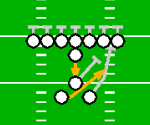Description

No wishbone attack is complete unless it gets every running back involved. Until now that hasn't been the case for Wishbone-Big, but Power Stretch clears up that little oversight to flesh out the Wishbone-Big formation. This play uses the same blocking scheme that makes HB Lead Smash successful, only run to the opposite side. With a shuffle step replacing the hop step, this play executes a little more quickly and is well suited to the shifty, 3rd down type back which fills the backup halfback role on many NFL teams.
Though the word stretch may seem to imply that this run goes to the outside, in most situations it is really at its best cutting upfield before getting outside the tackle. Think of it in the mold of the Denver Broncos classic "one cut and go" type of play that has lead to a succession of 1000 yard backs for that team. The biggest runs often will come to the outside, but only if you get great blocking at the point of attack, or if the defense simply slants the wrong way, making the offensive line's job easy. More often you'll see short but steady gains between the tackles.
Player Assignments
| Position | Action |
|---|---|
| O-Line and TEs | Run Block |
| QB | Handoff to Right HB |
| FB | Lead Wide Right |
| Left HB | Shuffle Step - Sprint Right |
| Right HB | Lead Off Right |
See the Madden Playbook Guide for a description of these symbols.
Blocking Assessment
The blocking scheme of Power Stretch is conceptually very simple, the trick is getting in plenty of practice reps to get a feel for the flow of the blocking. Because the entire line blocks straight-ahead, the real issues to look at are whether any defenders get penetration, and whether your lead blocking FB and HB are able to take out any second level defenders or get stood up early. It's almost a zone blocking feel, where the back has to take the handoff and slide to his right until he sees a soft spot in the line (a true wide open hole is hard to come by from such a tight formation), and then BAM! cut upfield and hit the turbo. This cut may go anywhere from outside the tight end at a 45 degree angle to a sharp cut back to the inside between the center and right guard. The key is to be decisive. The soft spot may not appear immediately, but when it does it won't be there for long because the front seven can afford to crowd in close with no WRs split wide. Hesitation will kill you here, so you need to practice the play enough to learn to just trust your instincts instead of trying to methodically assess the defense during the action.
While the play must be executed instinctually after the snap, before the snap there are a number of options that can increase the play's chances of success. The Playmaker feature is useless for this run in Madden 2005, so it's up to motion to save the day if the defense presents an ugly look. If the defense brings its linebackers or safeties down close to the line of scrimmage, I like to motion the FB right, but then snap the ball just after he gets behind the O-line (just to the right of the QB). This gives him a jump on the defensive rush, letting him hit the defenders at the line instead of in the backfield. A bigger problem is when the cornerbacks are brought in tight. This cues a man coverage, and one option to counter is to motion the right HB over the left side. With luck this may trigger a defensive shift to compensate which will loosen up the defense at the point of attack and help reduce the chance of penetration, at the cost of only marginal lead blocking ability. The drawback is that it also reduces the chance of a big run to the outside where the right HB has the responsibility of sealing off the LOLB.
Analysis
Pros:
- Nice change of pace which makes use of the second HB
- Excellent play for shifty, quick cutting backs
- Flexibility in HB reads makes it difficult to repeatedly stop with a single defensive play
Cons:
- Requires a lot of practice to make executing the play instinctive
- Does not utilize the best runner in the backfield
- Generally does not perform well against defensive overstacks
Contact Arkaein with any comments or questions regarding the Monstrous Madden Playbook.